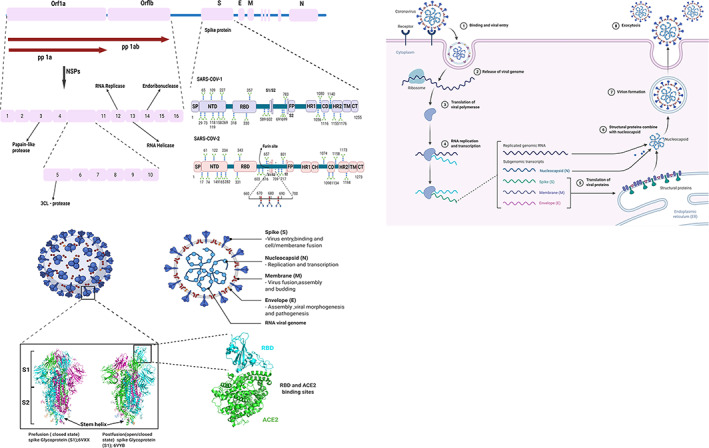FIGURE 1.

(a) Schematic representation of the SARS‐CoV‐2 genomic structure and multidomain structural juxtaposition of the SARS‐COV‐1 and SARS‐COV‐2 primary spike glycoprotein (not to scale). The region from ORF1a to ORF1b is expanded below to resolve nsp1–nsp16. The six accessory genes that encode six accessory proteins (orf3a, orf6, orf7a, orf7b, orf8, and orf10) are not shown. ORFs, open reading frame genes; S, spike protein gene; E, envelope protein gene; M, membrane protein gene; N, nucleocapsid protein gene. Schematic structure of the SARS‐COV‐2 spike glycoprotein domain consists of signal peptide (SP, 1–13), N‐terminal domain (NT,13–350) receptor‐binding domain (RBD, 319–541), furin protease cleavage sites (S1/S2), fusion peptide (FP, 788–806), heptad repeat 1 (HR1913–984))heptad repeat 2 central helix (CH, 987–1034), (HR2, 1163–1213) domain, transmembrane domain (TM, 1214–1237), and cytoplasmic terminal (CT, 1235–1273). The glycan and cleavage sites are depicted according to their position on the domains. (b) Schematic representation of the structure of SARS‐COV‐2 virus: Crystal structure/Cryo‐EM structure of Closed state (PDB: 6VXX) and open state (PDB: 6VYB) of SARS‐COV‐2 spike glycoprotein and ACE2‐spike protein interaction. (c) Simplified SARS‐COV‐2 ACE2 receptor‐mediated host cell entry, replication cycle, and exocytosis. Reproducible under Creative Commons Attribution license CC0 1.0)
